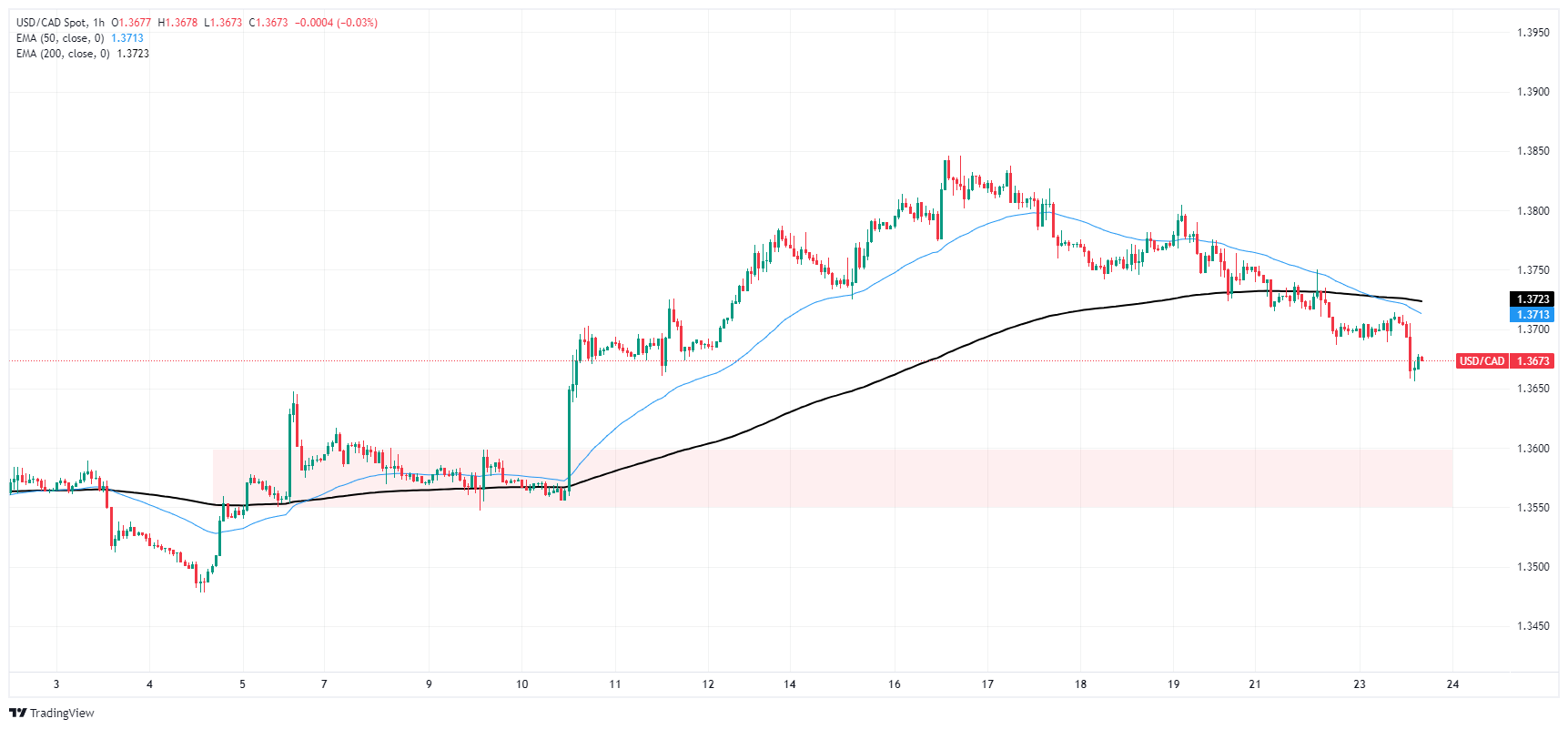- Canadian Dollar finds room against weaker Dollar after PMI.
- Canadian Retail Sales will be released on Wednesday, ahead of US GDP on Thursday.
- Despite the PMI gains, the CAD still has limited upside as crude oil continues to decline.
The Canadian Dollar (CAD) advanced against the US Dollar (USD) after US Purchasing Managers' Index (PMI) numbers came in weaker than expected. The moderation of economic activity in the US fuels market hopes that the US domestic economy will weaken enough to encourage the US Federal Reserve (Fed) to bring forward rate cuts.
Canada releases its latest retail sales figures on Wednesday, but market attention will focus on the US Gross Domestic Product (GDP) figures, due out on Thursday. The personal consumption expenditure (PCE) price index will be published on Friday.
Daily summary of market movements: Canadian dollar advances after dollar decline
- US PMI indices softened unexpectedly on Tuesday. The S&P Global Manufacturing PMI index stood at 49.9, below the 50.0 level for the first time in four months.
- The services PMI also lost weight and stood at 50.9, compared to the previous 51.7.
- Despite the US Dollar's weakness, the Canadian Dollar is trading mixed against major currencies as falling crude oil prices hurt the CAD.
- On Wednesday, Canadian retail sales for February are expected to recover to 0.1% from -0.3% the previous month.
- Canadian retail sales excluding automobiles are expected to be flat at 0.0%, down from 0.5% in January.
- US annualized quarterly GDP is forecast to decline to 2.5% from 3.4% previously.
- The March US core PCE price index is expected to remain stable at 0.3%.
- According to CME's FedWatch tool, rates markets are pricing in a 70% chance that the Fed will cut rates by at least 25 basis points in September.
Price of the Canadian Dollar today
Below is the percentage change of the Canadian Dollar (CAD) against the main currencies listed today. The Canadian dollar was the strongest currency against the US dollar.
| USD | EUR | GBP | CAD | AUD | JPY | NZD | CHF | |
| USD | -0.40% | -0.74% | -0.21% | -0.51% | -0.01% | -0.29% | -0.05% | |
| EUR | 0.40% | -0.34% | 0.19% | -0.10% | 0.39% | 0.12% | 0.33% | |
| GBP | 0.73% | 0.33% | 0.52% | 0.23% | 0.72% | 0.45% | 0.68% | |
| CAD | 0.21% | -0.19% | -0.52% | -0.29% | 0.20% | -0.07% | 0.15% | |
| AUD | 0.51% | 0.10% | -0.24% | 0.28% | 0.50% | 0.22% | 0.43% | |
| JPY | 0.01% | -0.42% | -0.77% | -0.22% | -0.51% | -0.29% | -0.04% | |
| NZD | 0.29% | -0.12% | -0.45% | 0.07% | -0.21% | 0.28% | 0.22% | |
| CHF | 0.06% | -0.35% | -0.70% | -0.17% | -0.44% | 0.05% | -0.24% |
The heat map shows the percentage changes of the major currencies against each other. The base currency is chosen in the left column, while the quote currency is chosen in the top row. For example, if you choose the Euro in the left column and scroll down the horizontal line to the Japanese Yen, the percentage change that appears in the box will represent EUR (base)/JPY (quote).
Canadian Dollar Technical Analysis: CAD Prepares to Continue Rising, But Strong Support Zone Looms
The Canadian dollar was mixed on Tuesday. It gained about a fifth against the US Dollar and the Japanese Yen (JPY). On the contrary, it lost half a percentage point against the British Pound (GBP).
USD/CAD lost the 1.3700 zone, while the Dollar fell against the Canadian Dollar. The pair reached an intraday support zone near 1.3660, and further down it is approaching a significant demand zone near 1.3600. With Tuesday's bearish momentum, the pair is on track to close in the red for the fifth day in a row.
Primary support lies at the 200 day EMA, just north of the 1.3500 level. A resurgence of US Dollar buying could drag USD/CAD back to the latest swing high near 1.3850.
USD/CAD hourly chart
USD/CAD daily chart
Pound Sterling FAQ
What is the Pound Sterling?
The British Pound (GBP) is the oldest currency in the world (886 AD) and the official currency of the United Kingdom. It is the fourth most traded currency unit in the world, with 12% of all transactions and an average of $630 billion per day, according to 2022 data.
Its key currency pairs are GBP/USD, also known as “Cable”, which represents 11% of the forex market, GBP/JPY, or the “Dragon” as it is known to traders (3%), and EUR/GBP (2%). The pound sterling is issued by the Bank of England (BoE).
How do Bank of England decisions influence the Pound Sterling?
The most important factor influencing the value of the Pound Sterling is the monetary policy decided by the Bank of England. The Bank of England bases its decisions on achieving its main objective of “price stability”, that is, a stable inflation rate of around 2%. Its main tool to achieve this is the adjustment of interest rates.
When inflation is too high, the Bank of England tries to contain it by raising interest rates, which makes access to credit more expensive for individuals and companies. This is generally positive for the GBP, as higher interest rates make the UK a more attractive place for global investors to park their money.
When inflation is too low, it is a sign that economic growth is slowing. In this scenario, the BoE will consider lowering interest rates to make credit cheaper, so that companies borrow more to invest in projects that generate growth.
How does economic data influence the value of the Pound?
The published data gauges the health of the economy and may influence the value of the Pound sterling. Indicators such as GDP, manufacturing and services PMIs, and employment can influence the direction of the Pound.
A strong economy is good for the British pound. Not only does it attract more foreign investment, but it may encourage the Bank of England to raise interest rates, which will directly strengthen the Pound. Otherwise, if economic data is weak, the pound is likely to fall.
How does the trade balance affect the Pound?
Another significant data for the pound sterling is the trade balance. This indicator measures the difference between what a country earns from its exports and what it spends on imports during a given period.
If a country produces highly sought-after exports, its currency will benefit exclusively from the additional demand created by foreign buyers wishing to purchase these goods. Therefore, a positive net trade balance strengthens a currency and vice versa for a negative balance.
Source: Fx Street
I am Joshua Winder, a senior-level journalist and editor at World Stock Market. I specialize in covering news related to the stock market and economic trends. With more than 8 years of experience in this field, I have become an expert in financial reporting.







